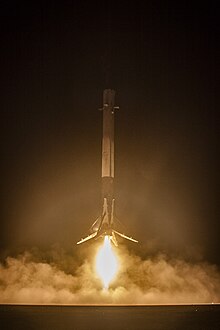Falcon 9 Flight 20


Falcon 9 flight 20 (also ORBCOMM OG-2 Mission 2 or ORBCOMM-2 for short ) was the 20th flight of a Falcon 9 rocket from the US private space company SpaceX . The launch took place on December 21, 2015 at 8:29 p.m. local time, Eastern Time (December 22, 01:29 a.m. UTC ). During the flight, it was possible for the first time to land the first stage of a rocket , which accounts for the largest part of the construction costs, safely on the earth's surface after a space flight . It touched down near the launch site about ten minutes after takeoff; there was no circumnavigation of the earth.
The commercial purpose of the rocket launches was the placement of eleven communications satellite the company Orbcomm in a low earth orbit , which also succeeded.
With these ORBCOMM-OG2 satellites, Orbcomm operates a communications network that can relay data from machines from anywhere on earth. It is used for applications such as container tracking, machine monitoring or the transmission of measurement data. SpaceX had already transported six ORBCOMM-OG2 satellites into space on July 14, 2014 with the tenth flight of a Falcon 9.
Take-off and landing site
The launch took place from Cape Canaveral AFS Launch Complex 40 , which SpaceX rented from the US Air Force . The landing took place on SpaceX's new Landing Zone 1 , a zone that had previously been used as Cape Canaveral AFS Launch Complex 13 (launch site 13). There were formerly Atlas - intercontinental ballistic missiles launched. SpaceX rented the complex in early 2015 for an initial five years, tore down the old facilities and had a landing pad built.
Upgraded rocket
SpaceX used the new version of its rocket for the launch without an official version name, which is often referred to as Falcon 9 v1.2 Full Thrust or usually shorter than Falcon 9 v1.2 . The ten Merlin 1D engines (nine in the first stage and one in the second stage) have another 30 percent more thrust than those used in the Falcon 9 v1.1 . The size and tank volume of the second stage have also been increased.
Remaining the first stage
On December 24th, the landing stage was brought to the Launch Complex 39A leased from SpaceX and then examined in the newly built hall there. Initial examinations showed no major damage, so it was decided to re-ignite the stage as a test. This took place on January 16, 2016 at LC-40 in Cape Canaveral, during which the engines were operated for a few seconds. The test was largely successful, only engine No. 9 showed some fluctuations. It has been on permanent display in front of SpaceX's corporate headquarters in Hawthorne since August 2016.
Background & meaning
For SpaceX founder Elon Musk is the recyclability of rockets and spaceships key condition for its strategic goal of enabling humanity to become a multiplanetare species and initially the planet Mars to colonize .
The successful return of the first stage of Falcon 9 Flight 20 was preceded by intensive development and testing with the test vehicles Grasshopper and Falcon 9 Reusable Development Vehicles (F9R Dev). The findings were incorporated into modifications of the first stage of actually deployed Falcon 9s, whereby, for safety reasons, the landing attempts were initially only made on the ocean and then on the autonomous spaceport drone ship .
In general, great importance is attached to the development of reusable rocket stages in the future of space travel or space transport. The first successful landing of one of these was therefore described by many as revolutionary and even placed in a row with the great breakthroughs in the history of space travel , such as the first manned moon landing .
In addition to SpaceX, other companies are currently working on the development of such reusable spacecraft, including the company Blue Origin of Amazon founder Jeff Bezos . Their New Shepard carrier system landed successfully on November 24, 2015 after a flight across the border into space . However, this is a purely experimental test vehicle, which, unlike the Falcon 9, did not put a load into orbit.
See also
- List of Falcon 9 missile launches
- Lars Blackmore , in charge of technology control for the return flight
Web links
- Elon Musk: Background on Tonight's Launch , company website spacex.com, December 21, 2015, accessed December 22, 2015
- Orbcomm's blog about the ORBCOMM OG2 mission 2
- Website Orbcomm over the ORBCOMM OG2 satellite network (English)
To the landing site:
- Stephen Clark: SpaceX leases property for landing pads at Cape Canaveral, Vandenberg , spaceflightnow.com, February 17, 2015
- Stephen Clark: Rocket landing at Cape Canaveral planned after SpaceX launch , spaceflightnow.com, December 19, 2015
Video:
Individual evidence
- ↑ James Dean: SpaceX launches Falcon 9 rocket, lands booster back on land . 11:01 pm EST December 21, 2015 , USAToday.com, accessed December 22, 2015
- ↑ Melody Petersen: SpaceX launches rocket and makes historic landing in Florida , Los Angeles Times website, December 21, 2015, accessed December 21, 2015
- ↑ SpaceX lands the "Falcon 9" launch vehicle for the first time. Arte , December 22, 2015, archived from the original on December 23, 2015 ; accessed on December 29, 2015 .
- ↑ http://www.orbcomm.com/en/networks/satellite/orbcomm-og2
- ↑ Stephen Clark: SpaceX leases property for landing pads at Cape Canaveral, Vandenberg , spaceflightnow.com, February 17, 2015, accessed December 22, 2015.
- ↑ Stephen Clark: Rocket landing at Cape Canaveral planned after SpaceX launch , spaceflightnow.com, December 19, 2015, accessed December 22, 2015.
- ↑ Peter B. de Selding: SpaceX Changes its Falcon 9 Return-to-flight Plans , spacenews.com of October 16, 2015, accessed on December 22, 2015
- ↑ Spaceflight Now: Recovered Falcon 9 booster fires again at Cape Canaveral. January 16, 2016, accessed January 17, 2016 .
- ↑ Spaceflightnow: SpaceX puts historic flown rocket on permanent display. Retrieved February 15, 2017 .



